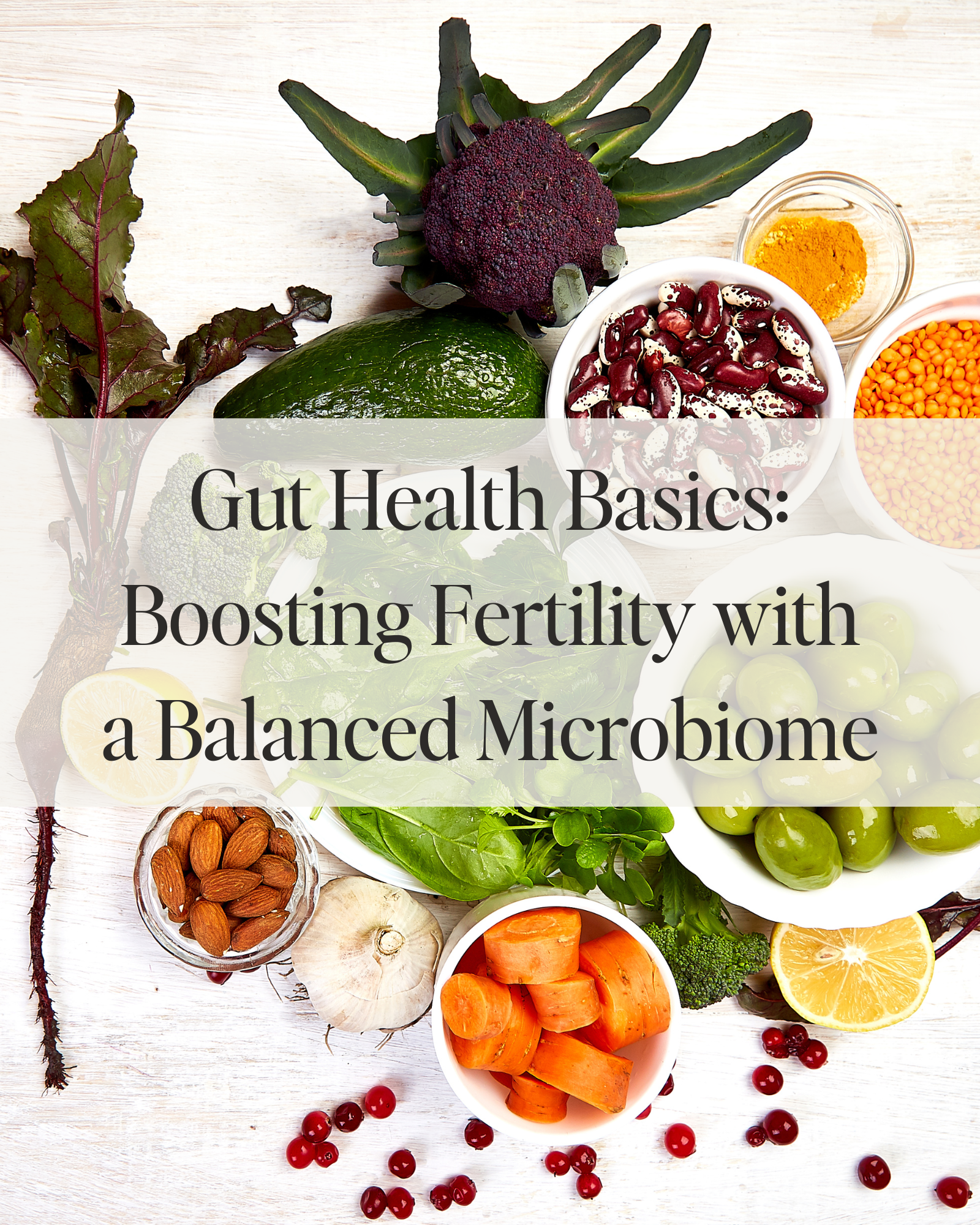Nutrition
Resources
Style
Planning
View All
Written by: Lauren Chamberlain
Edited and Reviewed By: Anabelle Clebaner MS, RDN
Did you know that your gut health could impact more than just digestion? From immunity to mental clarity, a healthy gut plays a pivotal role in overall well-being—and even fertility. Emerging research suggests that a balanced gut microbiome influences hormone regulation, immune function, and inflammation, all of which are crucial for reproductive health. Whether you’re looking to optimize fertility or improve general health, supporting your gut can be a game-changer for both your body and mind.
The Basic Functions of the Gut
Before diving into the more intricate details of gut health, it’s essential to understand the basic functions of the gut and why it plays such a crucial role in your overall health.
1. Digestion
The gut is responsible for breaking down the food we eat, allowing nutrients to be absorbed into the bloodstream. This process starts in the mouth and continues through the stomach and small intestine. Enzymes and acids help break down food into smaller molecules for absorption.
2. Nutrient Absorption
Once food is broken down, the small intestine absorbs essential nutrients—like vitamins, minerals, and amino acids—into the bloodstream. These nutrients are then transported throughout the body to fuel our cells and organs.
3. Immune Function
A large portion of the body’s immune system resides in the gut. It acts as a barrier to harmful pathogens, such as bacteria and viruses. A healthy gut microbiome— the community of beneficial bacteria—supports immune function and helps protect the body from infections and inflammation.
4. Detoxification
The gut plays a vital role in detoxifying the body by processing and eliminating waste. The liver, bile, and gut work together to filter out toxins, which are then excreted through the stool. This process helps maintain a clean internal environment.
5. Hormone Regulation
The gut is involved in hormone production and regulation. It helps control hormones related to digestion, hunger, and metabolism. Additionally, the gut microbiome can influence hormonal balance, which is vital for reproductive health.
6. Gut-Brain Connection
The gut and brain communicate through the gut-brain axis, a direct link between the two. This connection influences mood, mental clarity, and stress levels. Research suggests that an imbalance in the gut microbiome can impact mental health conditions like anxiety and depression.
By understanding these basic functions, we can see why maintaining a healthy gut is essential for overall well-being and fertility. Now, let’s dive deeper into how to support these functions for optimal health.
Understanding Gut Permeability and Leaky Gut
Leaky gut occurs when the intestinal barrier becomes compromised, allowing undigested food particles, toxins, and microbes to enter the bloodstream. This process can trigger systemic inflammation and is implicated in conditions like autoimmune diseases, irritable bowel syndrome (IBS), and even neuroinflammation. The protein zonulin regulates tight junctions in the gut lining, and its overproduction is associated with increased gut permeability.
Dietary choices, stress, and environmental toxins all influence this delicate balance.
The Role of Diet in Gut Health
Diet plays a crucial role in shaping gut microbiota and maintaining a strong intestinal barrier. Research suggests that:
- High-fiber foods (e.g., fruits, vegetables, whole grains) support beneficial bacteria and help regulate gut permeability.
- Healthy fats, such as omega-3s, promote anti-inflammatory gut conditions, whereas excessive saturated fat intake can negatively impact gut flora.
- Akkermansia muciniphila, a beneficial bacterium, is linked to improved gut barrier function, reduced inflammation, and better metabolic health.
- Bovine colostrum supplementation has been shown to decrease intestinal permeability and lower zonulin levels, particularly in athletes.
Small Intestinal Bacterial Overgrowth (SIBO) and Gut Dysfunction
SIBO occurs when there’s an overgrowth of bacteria in the small intestine. This can lead to bloating, malabsorption, and digestive discomfort. It’s often associated with IBS, celiac disease, and metabolic syndrome.
Managing SIBO:
- Get proper testing to identify SIBO.
- Modify your diet, focusing on low FODMAP foods.
- Consider probiotics to restore balance.
- Work with a healthcare provider to determine if antibiotics are necessary.
Gut Health and Systemic Wellness
Emerging research highlights the gut-brain connection, linking gut health to cognitive function, mood regulation, and neurological diseases like Alzheimer’s. The gut microbiome also plays a role in cardiovascular health, obesity, and diabetes. Fecal microbiota transplants (FMT) have even been explored as potential treatments for age-related cognitive decline and metabolic disorders.
Gut Health and Fertility
Emerging research suggests that gut health plays a crucial role in reproductive health. The gut microbiome influences hormone regulation, immune function, and inflammation, all of which impact fertility outcomes. Dysbiosis, or an imbalance of gut bacteria, has been linked to conditions like polycystic ovary syndrome (PCOS), endometriosis, and unexplained infertility.
- Hormonal Balance: The gut microbiome helps regulate estrogen levels through the estrobolome, a collection of bacteria involved in estrogen metabolism. An imbalance can lead to estrogen dominance, which is associated with infertility and conditions like PCOS.
- Inflammation and Immune Function: Chronic inflammation, often driven by poor gut health, has been implicated in endometriosis and implantation failure. A healthy gut barrier helps regulate immune responses and supports a favorable reproductive environment.
- Microbiome and Pregnancy Outcomes: Research suggests that a balanced gut microbiome contributes to healthy pregnancy outcomes, reducing the risk of gestational diabetes, preeclampsia, and preterm birth.
Supporting Digestion
Efficient digestion breaks down food properly, allowing for optimal nutrient absorption and minimizing digestive distress.
Ways to enhance digestion include:
- Incorporating bitter foods: Foods like arugula, artichoke, bitter melon, dandelion greens, Brussels sprouts, coffee, and grapefruit stimulate stomach acid and bile production.
- Using digestive aids: Digestive enzymes, HCl supplements, apple cider vinegar, or digestive bitters may be beneficial.
- Relaxing at meals: Stress can negatively impact digestion, so mindful eating practices are essential.
- Consuming adequate minerals: Sodium (from sea salt) and zinc (from oysters and red meat) support stomach acid production.
Supporting Healthy Bile Flow
Bile is critical for fat digestion and detoxification. Signs of inadequate bile include bloating, floating stools, nausea after eating fats, and vitamin deficiencies. To support bile production:
- Consume fiber-rich foods: Legumes, beans, and avocados help bind to excess bile.
- Eat bitter foods: These naturally promote bile flow.
- Use cholagogue herbs: Globe artichoke, dandelion, burdock, and Oregon grape enhance bile movement.
- Ensure adequate taurine intake: Meat, fish, shellfish, and eggs aid in bile salt production.
Supporting Beneficial Bacteria
A balanced gut microbiome is essential for digestion, immunity, and gut barrier integrity. To nurture beneficial bacteria:
- Prioritize digestion first: Ensuring proper food breakdown is key before increasing fiber intake.
- Incorporate prebiotic foods: Apples, asparagus, garlic, onions, oats, and legumes serve as fuel for gut bacteria.
- Limit excessive alcohol intake: Alcohol can cause dysbiosis and inflammation.
Supporting Liver Detoxification
The liver plays a crucial role in gut health through bile production and detox processes. To support liver function:
- Include Phase 1 detox foods: Magnesium (leafy greens, avocado), B vitamins (liver, eggs, seafood), vitamin C (citrus, bell peppers), and zinc (oysters, beef).
- Incorporate Phase 2 detox foods: Glycine (bone broth), glutamine (beef, spinach), cysteine (broccoli, eggs), and taurine (meat, fish).
Strengthening the Gut Lining
A strong intestinal barrier prevents harmful substances from entering the bloodstream. Factors that contribute to a leaky gut include stress, poor digestion, processed foods, overuse of medications, and imbalanced gut bacteria. To support gut integrity:
- Limit inflammatory foods: Avoid heavily processed and inflammatory oils.
- Boost beneficial fibers: Prebiotic and resistant starch-rich foods enhance gut lining health.
- Consume gut-supportive nutrients: Glutamine (cabbage, fish), zinc (beef, crab), and colostrum aid in healing the gut lining.
- Use gut-healing herbs: Marshmallow root, slippery elm, aloe vera, and licorice can be beneficial.
Strengthening the Immune System
A well-functioning immune system relies on strong digestion and a balanced gut microbiome. Factors that deplete immunity include poor digestion, chronic stress, hormonal imbalances, and long-term medication use. To support immune health:
- Improve digestion and gut microbiome health
- Incorporate immune-boosting foods: Colostrum, mushrooms (reishi, shiitake), and vitamin C-rich foods (citrus, mango, papaya) support immune function.
- Use supportive herbs: Andrographis, elderberry, echinacea, and astragalus help strengthen immunity.
Prebiotics & Resistant Starch
Prebiotics are fibers that feed beneficial bacteria and help produce short-chain fatty acids, which support gut integrity and immunity.
- Prebiotic foods: Apples, asparagus, garlic, onions, oats, and legumes.
- Resistant starch sources: Cooked and cooled potatoes, green bananas, and legumes.
By focusing on these key areas, you can create a solid foundation for optimal gut health and overall well-being. Making small, sustainable changes to your diet and lifestyle can have lasting positive effects on digestion, immunity, and energy levels.
Conclusion
Maintaining gut health is essential for overall well-being, from digestion and immunity to mental clarity and chronic disease prevention. By making mindful dietary and lifestyle choices, you can support a resilient gut microbiome and improve long-term health outcomes. The science is clear: a healthy gut is a foundation for a thriving body and mind.

Sources
- https://www.ncbi.nlm.nih.gov/pmc/articles/PMC6996528/
- https://www.ncbi.nlm.nih.gov/pmc/articles/PMC8305009/
- https://www.ncbi.nlm.nih.gov/pmc/articles/PMC6313445/
- https://pubmed.ncbi.nlm.nih.gov/38790992/
- https://pubmed.ncbi.nlm.nih.gov/32023228/
- https://www.ncbi.nlm.nih.gov/pmc/articles/PMC8058106/
- https://www.ncbi.nlm.nih.gov/pmc/articles/PMC8674859/
- https://pubmed.ncbi.nlm.nih.gov/25290618/
- https://pubmed.ncbi.nlm.nih.gov/35874661/
- https://pubmed.ncbi.nlm.nih.gov/34623232/
- https://www.imrpress.com/journal/FBL/26/5/10.52586/4921/htm
- https://www.nia.nih.gov/news/beyond-brain-gut-microbiome-and-alzheimers-disease
- https://pubmed.ncbi.nlm.nih.gov/34054740/
- https://pubmed.ncbi.nlm.nih.gov/28397754/
- https://pubmed.ncbi.nlm.nih.gov/35745242/
- https://pmc.ncbi.nlm.nih.gov/articles/PMC7971312/
- https://pubmed.ncbi.nlm.nih.gov/28778332/

Written by: Lauren Chamberlain
Edited and Reviewed By: Anabelle Clebaner MS, RDN
Hormonal contraceptives, including birth control pills, patches, injections, and intrauterine devices (IUDs), have transformed reproductive health, offering women reliable family planning options. However, many individuals experience symptoms after discontinuing hormonal contraception, a phenomenon sometimes referred to as post-birth control syndrome (PBCS). These symptoms can range from irregular cycles and acne to mood swings and digestive issues. Understanding the impact of hormonal contraceptives on the body and implementing strategies to support recovery can help ease this transition.
Understanding the Effects of Hormonal Contraceptives
Hormonal contraceptives work by suppressing ovulation, altering cervical mucus, and changing the uterine lining to prevent pregnancy. While effective, these changes influence several body systems, including the endocrine, digestive, and immune systems. Long-term use can disrupt the body’s natural hormone production, leading to potential withdrawal effects when stopping contraception.
A recent study found that hormonal contraceptives impact the hypothalamic-pituitary-adrenal (HPA) axis, which regulates stress response and hormone production. This may explain why some women experience mood disturbances and fatigue after discontinuation. Additionally, research suggests that birth control pills may alter gut microbiota composition, contributing to inflammation and digestive issues post-contraception.
The Role of the HPA Axis
The HPA axis plays a crucial role in regulating cortisol, a stress hormone that influences metabolism, immune function, and mood. Studies have shown that long-term contraceptive use can disrupt this delicate balance, leading to post-pill anxiety, fatigue, and even adrenal dysfunction. As the body readjusts, individuals may experience heightened stress sensitivity and emotional imbalances.
Additionally, research suggests that chronic hormonal suppression can contribute to reduced ovarian hormone production post-contraception, leading to symptoms like irregular cycles, low libido, and difficulty ovulating.
Common Symptoms After Stopping Hormonal Contraceptives
Post-birth control syndrome encompasses a variety of symptoms that may arise within weeks or months after stopping contraception.
Common symptoms include:
- Irregular or absent menstrual cycles
- Acne and skin changes
- Hair loss or thinning
- Digestive disturbances, including bloating and constipation
- Fatigue and mood swings
- Low libido
- Headaches and joint pain
These symptoms occur as the body attempts to restore natural hormone balance. For some, this transition is seamless, while for others, it may take several months to regulate.
Life After Birth Control: What to Expect
The transition off hormonal contraceptives varies for each individual. Some experience a smooth adjustment, while others face lingering hormonal imbalances.
- Menstrual Cycle Irregularities: It may take several months for cycles to regulate. If cycles remain absent or irregular for more than six months, professional evaluation is recommended. Ovulatory dysfunction is common post-contraception, particularly after long-term use of hormonal birth control. Tracking basal body temperature (BBT) and cervical mucus can provide insight into ovulation status and cycle health
- Acne and Skin Changes: Hormonal shifts can temporarily worsen acne. Supporting detox pathways, reducing dairy and sugar intake, and using non-comedogenic skincare products can help. Elevated androgens post-pill can contribute to excess sebum production, leading to breakouts. Incorporating zinc, omega-3 fatty acids, and antioxidants may promote clearer skin.
- Mood and Energy Levels: Some experience heightened anxiety or depression post-contraception. Prioritizing gut health, sleep, and stress reduction can ease this transition. The gut-brain axis plays a key role in mood regulation, making probiotics and a fiber-rich diet beneficial for mental well-being.
- Fertility Awareness: Some individuals regain fertility immediately, while others need time for ovulation to resume. Those trying to conceive may benefit from monitoring ovulation signs. If fertility does not return within six months, an evaluation for conditions like post-pill PCOS or hypothalamic amenorrhea may be necessary.
- Weight Fluctuations: Water retention and metabolism changes can impact weight. Focusing on whole foods, movement, and hydration supports a stable transition. Hormonal contraceptives can affect insulin sensitivity, and some women notice changes in blood sugar regulation post-pill. Balancing macronutrients and avoiding refined sugars can help stabilize weight.
- Increased Libido: Many report improved libido and natural cycle awareness after stopping hormonal contraceptives due to restored testosterone and estrogen levels.
Adjusting to life after birth control involves patience and self-care. Tracking symptoms, optimizing nutrition, and seeking support when needed can help individuals regain hormonal balance and overall well-being.
Supporting Hormonal Balance Post-Contraception
While post-birth control symptoms can be challenging, several strategies can support the body’s recovery and restore hormonal balance.
1. Nourishing Your Body with Key Nutrients
Hormonal contraceptives can deplete essential nutrients, including B vitamins, magnesium, zinc, and vitamin C. It has been found essential to replenish these nutrients to support metabolism, immune function, and hormone production.
Incorporating the following nutrient-dense foods can be beneficial:
- B Vitamins: Found in leafy greens, eggs, and whole grains
- Magnesium: Present in nuts, seeds, and dark chocolate
- Zinc: Found in oysters, beef, and lentils
- Vitamin C: Abundant in citrus fruits, bell peppers, and strawberries
Supplementing with a high-quality multivitamin or targeted nutrients may also help restore levels more efficiently.
2. Prioritizing Liver Health
The liver plays a crucial role in metabolizing hormones and detoxifying excess estrogen. Supporting liver function can aid hormone clearance and balance. Key strategies include:
- Drinking plenty of water to support detoxification
- Eating cruciferous vegetables (broccoli, cauliflower, kale) to promote estrogen metabolism
- Avoiding alcohol and excessive caffeine, which can burden the liver
- Taking liver-supporting supplements such as milk thistle and dandelion root
3. Balancing Blood Sugar Levels
Insulin resistance and blood sugar imbalances can contribute to hormonal dysregulation post-contraception. Stabilizing blood sugar helps maintain steady energy levels and prevents cortisol spikes, which can further disrupt hormones. To support blood sugar balance:
- Consume protein and healthy fats with every meal
- Avoid refined carbohydrates and excessive sugar
- Incorporate fiber-rich foods, such as legumes, nuts, and vegetables
- Engage in regular physical activity to improve insulin sensitivity
4. Restoring Gut Health
The gut microbiome influences hormone metabolism and immune function. Studies suggest that hormonal contraceptives may alter gut bacteria, leading to digestive issues and inflammation. Supporting gut health can enhance nutrient absorption and hormone clearance:
- Probiotic-Rich Foods: Yogurt, kimchi, sauerkraut, and kefir can replenish beneficial bacteria
- Prebiotic Fiber: Found in onions, garlic, bananas, and asparagus to support microbial diversity
- Bone Broth and Collagen: Aid in gut lining repair
- Limiting Processed Foods: Reducing inflammatory foods can alleviate digestive distress
- Fermented Foods and Fiber: Incorporating fermented foods like miso and fiber-rich foods such as flaxseeds can further support microbiome diversity
According to research, discontinuing birth control can cause shifts in the gut microbiome that affect estrogen metabolism and immune responses. A focus on gut healing post-contraception may accelerate hormonal recovery and reduce systemic inflammation.
5. Managing Stress and Prioritizing Sleep
Chronic stress and inadequate sleep can exacerbate hormonal imbalances. Since the HPA axis is affected by hormonal contraceptives, post-contraceptive recovery requires stress management techniques. Effective strategies include:
- Practicing mindfulness or meditation
- Engaging in gentle movement, such as yoga or walking
- Setting a consistent sleep schedule and avoiding blue light before bedtime
- Taking adaptogenic herbs, like ashwagandha or rhodiola, to support adrenal function
6. Tracking Your Menstrual Cycle
Monitoring menstrual patterns post-contraception provides insight into hormonal recovery. Using a cycle-tracking app or basal body temperature charting can help identify ovulation and cycle health.
- Basal Body Temperature (BBT): Measuring BBT each morning helps detect ovulation. A sustained temperature rise typically indicates ovulation has occurred.
- Cervical Mucus Changes: Observing cervical mucus consistency can signal fertility. Egg-white-like mucus usually indicates peak fertility.
- Cycle Length and Symptoms: Keeping track of cycle length, PMS symptoms, and flow characteristics provides valuable data about hormonal balance.
- Ovulation Predictor Kits: These kits measure luteinizing hormone (LH) surges, indicating the fertile window.
If menstruation does not return within three to six months, consulting a healthcare provider may be necessary to rule out underlying conditions like hypothalamic amenorrhea or PCOS.
7. Seeking Professional Support
If symptoms persist or become severe, working with a healthcare provider, such as a functional medicine/nutrition practitioner, can be beneficial. They can assess hormone levels, address underlying imbalances, and provide personalized recommendations for recovery.
Here are some issues you may need to address:
Prolonged Absence of Periods: If your period hasn’t returned after six months.
Persistent Acne or Severe Hair Loss: Significant changes in skin or hair health could indicate hormonal imbalances that require attention.
Excessive Mood Changes or Fatigue: If symptoms like mood swings, anxiety, or extreme tiredness persist.
Chronic Digestive Issues: Ongoing digestive disturbances such as bloating or constipation.
Conclusion
Recovering from hormonal contraceptives is a unique process for every individual. While some may transition smoothly, others may experience a range of symptoms as their body readjusts. By focusing on nutrient replenishment, liver and gut health, blood sugar balance, stress management, and cycle tracking, individuals can support their hormonal recovery more effectively. If challenges persist, seeking professional guidance can ensure a smoother transition and optimal long-term health.

Sources:
https://drbrighten.com/post-birth-control-syndrome
https://drbrighten.com/stopping-birth-control-side-effects
https://www.sciencedirect.com/science/article/pii/S0889159123003331?via%3Dihub
https://pmc.ncbi.nlm.nih.gov/articles/PMC6055351
https://drbrighten.com/the-contraception-guide/ https://www.kernodle.com/obgyn_blog/side-effects-of-stopping-the-pill-after-prolonged-use/

Written by: Lauren Chamberlain
Edited and Reviewed By: Anabelle Clebaner MS, RDN
If you’re trying to conceive, the food on your plate might be more important than you think! The link between diet and fertility is stronger than ever, with research showing that the right nutrition can make all the difference in hormone balance, egg and sperm quality, and overall reproductive health. Enter the Modified Mediterranean Diet – an upgraded version of one of the world’s healthiest eating patterns, tailored specifically for fertility support. Packed with antioxidants, healthy fats, and essential nutrients, this approach can help set the stage for a successful pregnancy. Let’s dive into how you can use food as a powerful tool to enhance fertility naturally!
The Role of Nutrition in Fertility
What you eat plays a direct role in shaping your reproductive health. A well-balanced diet provides the essential nutrients needed for hormone production, optimal egg and sperm quality, and a healthy reproductive system. Poor dietary choices, on the other hand, can lead to inflammation, oxidative stress, and metabolic imbalances, all of which can impair fertility.
One of the key factors in fertility is oxidative stress, which occurs when free radicals damage cells, including eggs and sperm. Antioxidant-rich foods such as berries, leafy greens, and nuts help neutralize these harmful compounds, protecting reproductive cells and improving their function. Research has shown that a diet high in antioxidants is linked to improved sperm motility and morphology, as well as better ovarian function in women.
Another crucial aspect is hormonal balance. Hormones like estrogen, progesterone, and testosterone rely on a steady supply of vitamins and minerals to function properly. Nutrients such as zinc, vitamin D, and omega-3 fatty acids support hormone synthesis and regulation, helping to optimize fertility. Consuming high-quality protein sources, healthy fats, and fiber-rich carbohydrates helps maintain stable hormone levels and reduces the risk of conditions like polycystic ovary syndrome (PCOS), which is a leading cause of infertility.
Additionally, mitochondrial health plays a significant role in reproductive success. Mitochondria, known as the powerhouses of the cell, provide the energy needed for fertilization and embryo development. Nutrients like CoQ10, found in fish, nuts, and organ meats, support mitochondrial function, ensuring that eggs and sperm have the energy required for optimal performance.
Finally, blood sugar stability is vital for fertility. High blood sugar levels can disrupt ovulation, impair egg quality, and contribute to insulin resistance, which is commonly associated with PCOS. A diet that prioritizes low-glycemic carbohydrates, lean proteins, and healthy fats can help regulate blood sugar levels and improve overall reproductive health.
By focusing on nutrient-dense foods that combat oxidative stress, support hormone production, enhance mitochondrial function, and stabilize blood sugar, you can create the best possible environment for conception and a healthy pregnancy.
Why the Modified Mediterranean Diet?
The Mediterranean diet has long been associated with numerous health benefits, including improved heart health, reduced inflammation, and better metabolic function. Studies have found that adherence to a Mediterranean diet is linked to increased fertility, improved assisted reproductive technology (ART) outcomes, and better pregnancy success rates.
However, for optimal fertility benefits, modifications to the traditional Mediterranean diet can enhance its effects. A modified Mediterranean diet prioritizes lower glycemic load foods, nutrient-dense proteins, and specific fertility-enhancing nutrients.
Understanding Glycemic Index vs. Glycemic Load
People often hear about glycemic index (GI) and glycemic load (GL) when discussing blood sugar management, but they are not the same. The glycemic index measures how quickly a carbohydrate-containing food raises blood sugar on a scale from 0 to 100. However, it does not account for portion size. Glycemic load, on the other hand, considers both the GI and the amount of carbohydrates in a typical serving, giving a more accurate picture of a food’s impact on blood sugar. For fertility, focusing on low glycemic load foods is more beneficial for stabilizing blood sugar and hormone balance.
Read more about how to balance blood sugar through your meals here.
Key Components of the Modified Mediterranean Diet
1. Healthy Fats for Hormone Balance
Healthy fats play a vital role in hormone production and cell membrane integrity. The modified Mediterranean diet emphasizes:
- Extra virgin olive oil
- Avocados
- Nuts and seeds (e.g., walnuts, flaxseeds, almonds)
- Omega-3-rich fatty fish (e.g., salmon, sardines, mackerel)
- Grass-fed animal fats in moderation
These fats support reproductive hormone function and reduce inflammation, benefiting egg and sperm quality.
2. High-Quality Protein Sources
Protein is essential for reproductive health, but the source matters. This diet focuses on:
- Grass-fed beef and pasture-raised poultry
- Wild-caught fish
- Eggs (rich in choline and vitamin B12)
- Legumes and lentils
- Full-fat dairy (linked to improved ovulation in women with PCOS)
Protein from high-quality sources supports mitochondrial function in eggs and sperm and provides key amino acids necessary for hormone production.
3. Antioxidant-Rich Foods
Oxidative stress is a significant contributor to poor egg and sperm quality. The modified Mediterranean diet is rich in antioxidants that combat free radical damage:
- Berries (blueberries, raspberries, strawberries)
- Dark leafy greens (spinach, kale, Swiss chard)
- Cruciferous vegetables (broccoli, Brussels sprouts)
- Herbs and spices (turmeric, ginger, rosemary)
A diet high in antioxidants has been shown to improve sperm motility and morphology while enhancing egg quality.
4. Low-Glycemic Carbohydrates
Blood sugar imbalances can negatively impact fertility, particularly in individuals with insulin resistance or PCOS. This diet reduces refined grains and includes:
- Quinoa, farro, and barley in moderation
- Sweet potatoes, squash, and beets
- Legumes and lentils for fiber and protein
Stabilizing blood sugar through a low-glycemic diet helps regulate ovulation and improve egg quality.
5. Essential Micronutrients for Fertility
Several key vitamins and minerals are essential for reproductive health:
- Folate & B Vitamins: Support methylation and DNA synthesis (found in leafy greens, beans, and liver).
- Vitamin D: Linked to improved ovarian function and implantation (from sunlight, fatty fish, and fortified dairy).
- Zinc: Essential for sperm production and egg maturation (in nuts, seeds, and shellfish).
- CoQ10: Supports mitochondrial function in eggs and sperm (in grass-fed meat, fish, and supplements).
- Choline: Crucial for fetal brain development and egg quality (in eggs and liver).
Learn more about my recommendations for prenatal supplements here.
Practical Meal Ideas for Fertility Support
To make following this diet easier, here are additional meal ideas:
Breakfast:
- Greek yogurt parfait with walnuts, chia seeds, and fresh berries.
- Scrambled eggs with sautéed spinach, tomatoes, and feta cheese on whole-grain toast.
- Oatmeal with almond butter, flaxseeds, and a sprinkle of cinnamon.
Lunch:
- Grilled salmon with quinoa, steamed asparagus, and a drizzle of olive oil.
- Mediterranean chickpea salad with cucumbers, cherry tomatoes, red onion, feta cheese, and olive oil dressing.
- Lentil soup with a side of whole-grain bread and a mixed greens salad.
Dinner:
- Grass-fed steak with sweet potato mash and roasted Brussels sprouts.
- Baked cod with a side of roasted vegetables (zucchini, bell peppers, eggplant) and brown rice.
- Chicken and vegetable stir-fry with cauliflower rice and sesame ginger dressing.
Snacks:
- Hummus with carrot and celery sticks.
- A handful of almonds and dark chocolate.
- Cottage cheese with flaxseeds and sliced peaches.
- Hard-boiled eggs with a sprinkle of sea salt.
Lifestyle Considerations for Fertility
In addition to diet, lifestyle factors play a crucial role in optimizing fertility:
- Stress Management: Chronic stress disrupts hormonal balance. Incorporate mindfulness, yoga, or meditation.
- Sleep Hygiene: Poor sleep affects hormone regulation. Aim for 7-9 hours of quality sleep per night.
- Exercise: Moderate exercise improves fertility, but excessive exercise can have negative effects, particularly on ovulation.
- Reducing Toxins: Minimize exposure to endocrine disruptors such as BPA and phthalates found in plastics and personal care products.
Research Insights and Case Studies
Several studies highlight the success of dietary modifications in improving fertility:
- Women who adhered to a Mediterranean-style diet had a 65% higher chance of conception through IVF.
- A study found that men following a nutrient-rich diet improved their sperm parameters within just three months.
- Higher adherence to the Mediterranean diet was associated with a 40% lower risk of ovulatory infertility in women.
- Couples undergoing fertility treatments who followed a Mediterranean-style diet had a 30% higher live birth rate compared to those who did not.
- A study on male fertility found that men with a diet rich in antioxidants and omega-3 fatty acids had 20% higher sperm motility and 15% better morphology than those consuming a Western-style diet.
- Women who consumed higher levels of folate and vitamin B12 had a 50% lower risk of miscarriage compared to those with lower intake.
Conclusion
A modified Mediterranean diet offers a comprehensive and evidence-based approach to improving fertility. By emphasizing nutrient-dense foods, balancing blood sugar, and supporting mitochondrial function, this dietary pattern can enhance reproductive health for both men and women. Coupled with a healthy lifestyle, these dietary modifications can significantly improve conception outcomes and pave the way for a healthy pregnancy.
Fertility is a complex journey, and while diet alone may not guarantee success, it plays a crucial role in creating the best possible conditions for conception. Every small change—whether it’s adding more antioxidant-rich foods, choosing high-quality proteins, or reducing processed carbohydrates—can have a profound impact on reproductive health.
If you’re trying to conceive, consider incorporating these dietary principles into your daily routine. Start by making simple swaps, such as using extra virgin olive oil instead of processed vegetable oils or choosing whole grains over refined grains. Focus on consuming a variety of colorful fruits and vegetables, lean proteins, and healthy fats. Additionally, be mindful of lifestyle factors such as stress management, sleep quality, and physical activity, all of which influence fertility.
Now is the time to take charge of your fertility health! Whether you’re planning to conceive soon or in the future, these dietary and lifestyle changes can set the foundation for a healthier pregnancy and baby. If you need personalized guidance, consider working with a nutritionist or healthcare professional specializing in fertility nutrition to tailor a plan that meets your unique needs.
Start today—your future self (and baby) will thank you!

Sources
https://pmc.ncbi.nlm.nih.gov/articles/PMC8909876
https://pmc.ncbi.nlm.nih.gov/articles/PMC2846864
https://pmc.ncbi.nlm.nih.gov/articles/PMC4475051
https://pmc.ncbi.nlm.nih.gov/articles/PMC10005661

If you’ve been diagnosed with Polycystic Ovary Syndrome (PCOS), you’ve probably been told that birth control is the go-to solution. While it can help regulate cycles and manage symptoms, it’s not a one-size-fits-all fix—and it certainly doesn’t address the root causes of PCOS. The good news? There are plenty of science-backed, natural strategies to help you take control of your health, balance your hormones, and feel your best. From nutrition and exercise to stress management and supplements, this article explores effective alternatives to birth control for managing PCOS.
Understanding PCOS and Its Symptoms
PCOS is a complex endocrine disorder characterized by hyperandrogenism, ovulatory dysfunction, and polycystic ovarian morphology. It is associated with disruptions in the hypothalamic-pituitary-ovarian (HPO) axis, leading to irregular menstrual cycles and anovulation. Elevated levels of luteinizing hormone (LH) relative to follicle-stimulating hormone (FSH) contribute to excessive ovarian androgen production, resulting in clinical manifestations such as hirsutism, acne, and alopecia.
Insulin resistance is a central feature of PCOS, affecting up to 70% of individuals with the condition. Hyperinsulinemia exacerbates ovarian androgen secretion and inhibits hepatic production of sex hormone-binding globulin (SHBG), further increasing circulating free androgens. This metabolic dysfunction predisposes individuals to weight gain, dyslipidemia, and an increased risk of type 2 diabetes and cardiovascular disease.
Additionally, PCOS is associated with chronic low-grade inflammation, as evidenced by elevated levels of inflammatory markers such as C-reactive protein (CRP) and interleukin-6 (IL-6). These inflammatory pathways may contribute to the pathophysiology of insulin resistance and ovarian dysfunction. Given the heterogeneity of PCOS phenotypes, a personalized and multifaceted approach that addresses both endocrine and metabolic abnormalities is essential for effective symptom management.
1. Nutrition for PCOS Management
Diet plays a crucial role in managing PCOS symptoms. The right food choices can help regulate blood sugar levels, reduce inflammation, and balance hormones.
Prioritize Whole, Nutrient-Dense Foods
A diet rich in whole, unprocessed foods can significantly improve PCOS symptoms. Key dietary guidelines include:
- Low Glycemic Index (GI) Carbohydrates: Foods like whole grains, legumes, and non-starchy vegetables help regulate blood sugar levels.
- Healthy Fats: Incorporating sources such as avocados, nuts, seeds, and olive oil can improve insulin sensitivity and support hormone production.
- Lean Proteins: Chicken, fish, tofu, and legumes can help maintain stable blood sugar and support muscle mass.
Reduce Inflammatory Foods
Chronic inflammation is a common feature of PCOS. To minimize inflammation, avoid:
- Processed foods high in seed oils and refined sugars
- Excessive dairy and gluten (which may exacerbate inflammation in some individuals)
- Artificial additives and preservatives
Support Gut Health
The gut microbiome plays a significant role in hormone regulation. Probiotic-rich foods such as yogurt, kefir, kimchi, and sauerkraut can improve gut health and support metabolic balance.
2. Exercise and Movement
Regular physical activity is one of the most effective ways to improve insulin sensitivity, regulate menstrual cycles, and manage weight with PCOS.
Strength Training
Resistance training, including weight lifting and bodyweight exercises, can enhance insulin sensitivity, support lean muscle mass, and improve metabolic health.
Cardio Workouts
Moderate-intensity cardio exercises like brisk walking, cycling, or swimming can improve cardiovascular health and help with weight management.
Mindful Movement
Yoga and Pilates can help lower cortisol (stress hormone) levels and improve hormone balance, making them beneficial for managing PCOS symptoms.
3. Brown Fat and PCOS
Recent research has highlighted the potential role of brown adipose tissue (BAT), commonly known as brown fat, in managing Polycystic Ovary Syndrome (PCOS). Unlike white fat, which stores energy, brown fat burns calories to generate heat, thereby enhancing metabolism. This thermogenic property of brown fat can improve insulin sensitivity and metabolic health, which are often compromised in women with PCOS.
Strategies to Activate Brown Fat:
- Cold Exposure: Regular exposure to cold temperatures can stimulate brown fat activity. Practices such as cold showers or spending time in cooler environments may enhance BAT function.
- High-Intensity Interval Training (HIIT): Engaging in HIIT exercises has been associated with increased brown fat activation, contributing to improved metabolic outcomes.
- Dietary Choices: Consuming foods rich in healthy fats, particularly omega-3 fatty acids found in fish oil and flaxseeds, may support brown fat activity and overall metabolic health.
Incorporating these strategies into a holistic lifestyle approach may offer additional benefits for managing PCOS symptoms, complementing other interventions such as nutrition, exercise, stress management, and supplementation.
4. Stress Management and Sleep
Chronic stress and poor sleep can worsen PCOS symptoms by elevating cortisol levels and disrupting hormonal balance.
Stress-Reduction Techniques
- Meditation and Deep Breathing: Practicing mindfulness and controlled breathing can help reduce stress hormones.
- Journaling and Therapy: Expressing emotions and seeking professional support can help manage stress and anxiety related to PCOS.
- Spending Time in Nature: Outdoor activities and exposure to sunlight can help regulate circadian rhythms and improve mood.
Prioritizing Quality Sleep
- Maintain a Consistent Sleep Schedule: Going to bed and waking up at the same time each day supports hormonal balance.
- Limit Screen Time Before Bed: Blue light exposure from screens can disrupt melatonin production, affecting sleep quality.
- Create a Restful Sleep Environment: Keep your bedroom cool, dark, and free from distractions to promote deep sleep.
5. Natural Supplements for PCOS
Several supplements have been shown to support hormonal balance and improve PCOS symptoms.
Inositol
Myo-inositol and D-chiro-inositol are B-vitamin-like compounds that improve insulin sensitivity and ovarian function, helping to regulate menstrual cycles and reduce androgen levels.
Omega-3 Fatty Acids
Found in fish oil and flaxseeds, omega-3s help reduce inflammation, support heart health, and may improve insulin resistance in women with PCOS.
Vitamin D
Many women with PCOS have low vitamin D levels, which can contribute to insulin resistance and hormonal imbalances. Supplementing with vitamin D can improve metabolic and reproductive health.
Magnesium
Magnesium supports muscle relaxation, reduces inflammation, and helps regulate blood sugar levels, making it beneficial for women with PCOS.
6. NAC Over Metformin
N-Acetylcysteine (NAC) is gaining attention as a natural alternative to metformin for managing insulin resistance in PCOS.
NAC has been shown to:
- Improve insulin sensitivity
- Reduce oxidative stress and inflammation
- Support detoxification and liver health
- Promote ovulation and improve fertility outcomes
While metformin is a commonly prescribed medication for PCOS-related insulin resistance, it often comes with gastrointestinal side effects. NAC provides similar benefits without the discomfort, making it a promising option for those looking for natural interventions.
7. Alternative Therapies
Holistic approaches can complement lifestyle changes and provide additional support for PCOS management.
Acupuncture
Acupuncture has been found to improve ovulation, reduce androgen levels, and enhance insulin sensitivity in women with PCOS.
Herbal Medicine
- Spearmint Tea: Studies suggest that drinking spearmint tea may help lower testosterone levels and reduce hirsutism (excess hair growth).
- Cinnamon: This common spice has been shown to improve insulin sensitivity and regulate menstrual cycles in women with PCOS.
- Licorice Root: Used in traditional medicine, licorice root may help reduce androgen levels and support adrenal health.
8. Managing PCOS and Fertility
For women trying to conceive, lifestyle and dietary changes can significantly improve fertility outcomes without the need for birth control or medication.
Maintain a Healthy Weight
Even a modest weight loss of 5-10% can improve ovulation and increase the chances of conception.
Track Ovulation
Using basal body temperature (BBT) charting or ovulation predictor kits can help women with PCOS identify their most fertile days.
Consider Fertility-Supporting Supplements
Coenzyme Q10 (CoQ10), N-acetylcysteine (NAC), and vitamin B complex can support egg quality and reproductive function.
Conclusion
While birth control pills can be effective for managing PCOS symptoms, they are not the only solution. A holistic approach that includes dietary changes, exercise, stress management, and alternative therapies can provide long-term relief and improve overall well-being. Every woman’s journey with PCOS is unique, and finding the right combination of lifestyle modifications and natural treatments can empower individuals to take control of their health.

Sources
https://pmc.ncbi.nlm.nih.gov/articles/PMC9160465
https://doi.org/10.1002/ptr.2900
https://obgyn.onlinelibrary.wiley.com/doi/10.1111/j.1447-0756.2012.01844.x
https://ijmr.org.in/issue/2015-142-3
https://translational-medicine.biomedcentral.com/articles/10.1186/s12967-021-02817-2
https://www.degruyter.com/document/doi/10.7556/jaoa.2020.050/html

Ovulation is a fundamental aspect of reproductive health, marking the release of a mature egg from the ovary. This process is not only essential for conception but also serves as a key indicator of overall health, reflecting hormonal balance, metabolic stability, and adequate nutrient intake. However, various factors—including stress, sleep, and lifestyle choices—can influence ovulatory function. Among these, nutrition plays one of the most significant roles in regulating ovulation, supporting hormone production, and enhancing fertility.
Dietary choices directly affect ovarian function, with certain nutrients promoting hormonal equilibrium, follicular development, and cycle regularity, while others may contribute to anovulation, irregular cycles, and hormonal imbalances. Understanding the connection between nutrition and ovulation can empower individuals to make informed dietary choices that support reproductive health.

Understanding Ovulation and Its Importance
Ovulation occurs mid-cycle, typically around day 14 of a 28-day cycle, when a surge in luteinizing hormone (LH) triggers the release of a mature egg. This event is crucial for natural conception, as fertilization can only occur if a viable egg is available. However, ovulation is more than just a fertility marker—it is a reflection of a woman’s overall health.
Regular ovulation is associated with:
- Hormonal balance – The interplay of estrogen, progesterone, LH, and follicle-stimulating hormone (FSH) ensures normal menstrual cycles and reproductive health.
- Bone health – Estrogen, which fluctuates during the menstrual cycle, plays a key role in calcium absorption and maintaining bone density. Disruptions in ovulation can contribute to long-term skeletal issues such as osteoporosis.
- Cardiovascular function – Estrogen is also essential for heart health, helping regulate cholesterol levels and protect against cardiovascular disease. Women with irregular ovulation often have higher risks of heart disease due to hormonal imbalances.
- Metabolic stability – Regular ovulation is linked to better insulin sensitivity and stable blood sugar levels, reducing the risk of developing metabolic conditions such as type 2 diabetes.
On the other hand, disruptions in ovulation—such as anovulation (lack of ovulation), irregular cycles, or skipped periods—can signal underlying health concerns. Conditions like polycystic ovary syndrome (PCOS), hypothalamic amenorrhea, thyroid dysfunction, and insulin resistance often present with ovulatory disturbances. These conditions can be influenced by diet, exercise, stress, and other lifestyle factors, making nutritional strategies an essential component of ovulatory health.
Key Nutrients That Support Ovulation
Several vitamins and minerals are essential for healthy ovulation and menstrual cycle regulation.
Folate (Vitamin B9)
Folate is critical for DNA synthesis, cell division, and hormone regulation. While it is widely recognized for its role in preventing neural tube defects, research shows that adequate folate intake can enhance ovulatory function. A 2023 study found that women with higher folate levels had a lower risk of ovulatory disorders and improved fertility outcomes.
Best sources: Leafy greens (spinach, kale), lentils, chickpeas, asparagus, and avocados.

Inositol (Myo-Inositol & D-Chiro-Inositol)
Inositol, particularly myo-inositol, plays a crucial role in insulin signaling and ovarian function. Insulin resistance is a major contributor to ovulatory dysfunction, particularly in women with PCOS. Studies suggest that inositol supplementation can improve insulin sensitivity, regulate menstrual cycles, and enhance ovulation rates.
- Best sources: Citrus fruits, whole grains, beans, and nuts.
Omega-3 Fatty Acids
Omega-3s reduce inflammation, support hormone synthesis, and regulate menstrual cycles. Research published in Prostaglandins, Leukotrienes & Essential Fatty Acids found that omega-3 supplementation is associated with improved ovulatory function and reduced risk of anovulation.
- Best sources: Fatty fish (salmon, sardines, mackerel), flaxseeds, walnuts, chia seeds.
Vitamin D
Vitamin D plays a role in modulating reproductive hormones, including FSH and anti-Müllerian hormone (AMH), which are essential for ovarian reserve and egg quality. Deficiency has been linked to irregular cycles and ovulatory dysfunction.
- Best sources: Sun exposure, fortified dairy products, egg yolks, and fatty fish.
Zinc
Zinc is essential for follicular development, egg maturation, and progesterone production. A deficiency can lead to delayed ovulation and reduced fertility.
Best sources: Oysters, pumpkin seeds, chickpeas, beef, and cashews.

Magnesium
Magnesium is crucial for hormonal balance, stress regulation, and progesterone production. Research suggests that magnesium supplementation can support ovulatory function and improve menstrual cycle regularity.
- Best sources: Leafy greens, almonds, dark chocolate, and bananas.
Dietary Patterns for Optimal Ovulation
Beyond individual nutrients, overall dietary patterns significantly influence ovulation and fertility.
The Mediterranean Diet

A Mediterranean-style diet, rich in anti-inflammatory and nutrient-dense foods, is associated with higher fertility rates and improved ovulatory function.
Key components:
✔ Fatty fish (rich in omega-3s)
✔ Fresh fruits and vegetables (high in antioxidants)
✔ Whole grains and legumes (low glycemic index)
✔ Healthy fats (olive oil, nuts, seeds)
Low Glycemic Index (GI) Diet
A low-GI diet stabilizes blood sugar levels and improves insulin sensitivity, which is particularly beneficial for women with PCOS-related ovulatory dysfunction.
Anti-Inflammatory Diet
Chronic inflammation contributes to hormonal imbalances and ovulatory irregularities. An anti-inflammatory diet includes omega-3-rich foods, leafy greens, nuts, and herbs like turmeric and ginger.
Foods and Habits That Can Disrupt Ovulation
Certain dietary and lifestyle factors can negatively impact reproductive health:
Excess sugar and refined carbs – Can increase insulin resistance, disrupting ovulation.
Trans fats and processed foods – Linked to increased inflammation and hormonal imbalances.
Excess caffeine and alcohol – Can interfere with reproductive hormones and lower fertility.
Extreme dieting or under-eating – Can cause hypothalamic amenorrhea, leading to ovulation loss.
Lifestyle Factors That Enhance Ovulation
Beyond diet, several lifestyle factors can improve ovulatory function:
✔ Regular Exercise – Moderate activity supports hormone regulation, while excessive high-intensity exercise may negatively impact ovulation.
✔ Stress Management – Chronic stress elevates cortisol, which can suppress ovulation. Mindfulness, yoga, and meditation help reduce stress-related hormonal disruptions.
✔ Quality Sleep – Poor sleep disrupts reproductive hormones, leading to irregular cycles and ovulatory dysfunction. Aim for 7-9 hours of quality sleep per night.
Quality Prenatals and the MTHFR Gene
When preparing for pregnancy or supporting reproductive health, taking a high-quality prenatal vitamin is essential. Prenatals help ensure that women get the key nutrients needed for healthy ovulation and a successful pregnancy, even before conception occurs. A quality prenatal should contain at least 400-800 mcg of methylated folate, iron, calcium, vitamin D, iodine, and omega-3 fatty acids.

When to Start Taking Prenatals:
It’s advisable to begin taking prenatal vitamins at least 1-3 months before trying to conceive. This allows the body to build up stores of essential nutrients, particularly folate, which is crucial for fetal development and preventing neural tube defects. If there’s a known issue with ovulation or other reproductive health concerns, starting prenatal vitamins earlier can be beneficial.
Choosing a Quality Prenatal: Not all prenatal vitamins are created equal. Look for brands that are third-party tested for purity and potency. Some reputable brands include:
- FullWell – Known for its high-quality, bioavailable ingredients, including methylated folate for optimal absorption.
- Seeking Health – Offers a comprehensive prenatal formula with L-methylfolate and other key nutrients for reproductive health.
- Needed – A newer brand with an emphasis on clean, evidence-based ingredients, including methylated folate and Omega-3s.
- Thorne Research – Offers a highly bioavailable form of folate (L-methylfolate) and is known for its rigorous testing standards.
- Theralogix – Provides a well-rounded prenatal with the active form of folate (5-MTHF), ensuring better absorption and supporting overall fertility.
MTHFR Gene and Methylated Folate: The MTHFR gene plays a critical role in processing folate in the body. People with certain mutations in the MTHFR gene may have difficulty converting synthetic folic acid into its active form, 5-methyltetrahydrofolate (methylated folate). This can lead to higher homocysteine levels, which may increase the risk of cardiovascular issues and reproductive complications, including difficulty with conception.
For those with an MTHFR mutation, taking methylated folate instead of regular folic acid is recommended. Methylated folate is the form the body can directly use, making it more effective for those with MTHFR gene mutations. Many high-quality prenatal vitamins offer methylated folate (often labeled as L-methylfolate or 5-MTHF) to bypass the need for the conversion process.
Before starting a prenatal vitamin regimen, especially if there’s a concern about MTHFR mutations or other health issues, it’s always wise to consult with a healthcare provider or registered dietitian to ensure you’re selecting the best prenatal and dosage for your needs.
Final Thoughts
Ovulation is not just about fertility—it is a vital indicator of overall health. A nutrient-rich, anti-inflammatory diet and a balanced lifestyle can enhance ovulatory function, regulate menstrual cycles, and support fertility potential. If you experience irregular ovulation, consider working with a registered dietitian or healthcare provider to develop a personalized nutrition and lifestyle plan tailored to your needs.
By making small but meaningful dietary and lifestyle adjustments, you can optimize ovulation and support long-term reproductive health.
Sources
https://pmc.ncbi.nlm.nih.gov/articles/PMC11215161
https://pmc.ncbi.nlm.nih.gov/articles/PMC10475284/#s0005
https://www.sciencedirect.com/science/article/pii/S1389945706006216
https://pmc.ncbi.nlm.nih.gov/articles/PMC11013220
https://pmc.ncbi.nlm.nih.gov/articles/PMC8634384/#:~:text=Conversely%2C%20a%20diet%20based%20on,positive%20impact%20on%20female%20fertility https://pmc.ncbi.nlm.nih.gov/articles/PMC10309424/

Secondary infertility—the challenge of conceiving or carrying a pregnancy to term after previously giving birth—can be an emotional and frustrating experience for many families. But just remember: you’re not alone. This condition affects about 10% of couples. The good news is that functional nutrition offers an empowering way to address some of the root causes of secondary infertility, supporting your body and boosting your chances of growing your family. In this post, we’ll explore evidence-based nutritional strategies to help you on your journey.

Secondary infertility is complex, with causes ranging from hormonal imbalances and structural issues to lifestyle factors like stress and diet. Age-related fertility changes, ovulation disorders, diminished ovarian reserve, and male infertility are common culprits. Functional nutrition focuses on addressing these root causes through personalized dietary and lifestyle changes, helping to create the best possible conditions for conception and a healthy pregnancy.
How Functional Nutrition Supports Fertility
Functional nutrition takes a whole-person approach, targeting underlying factors that might be affecting your fertility. From reducing inflammation to balancing hormones, these strategies are here to support your health and your baby dreams. Let’s dive into the key areas:
1. Taming Oxidative Stress
Oxidative stress—an imbalance between damaging free radicals and protective antioxidants—can harm both egg and sperm quality. Research reveals that oxidative stress disrupts hormone production and even affects embryo implantation.
Oxidative stress is particularly problematic because it can reduce ovarian reserve and negatively impact sperm motility and morphology. Studies emphasize the importance of addressing oxidative damage to improve reproductive outcomes. Furthermore, chronic oxidative stress can exacerbate conditions like endometriosis and polycystic ovary syndrome (PCOS), compounding fertility challenges.

Here’s how to tackle oxidative stress:
- Eat Your Antioxidants: Fill your plate with colorful fruits and veggies like berries, oranges, spinach, and bell peppers. Antioxidant-rich foods combat oxidative damage and protect reproductive cells.
- Boost Omega-3s: Fatty fish like salmon and plant-based options like flaxseeds and walnuts help lower inflammation and protect against oxidative stress.
- Consider CoQ10: This powerful antioxidant, found in organ meats and supplements, improves mitochondrial function in eggs and sperm, enhancing their quality and viability.
- Include Vitamin E and C: These vitamins work synergistically to neutralize free radicals and improve reproductive outcomes. Nuts, seeds, citrus fruits, and strawberries are excellent sources.
- Explore Selenium and Glutathione: Selenium, found in Brazil nuts, and glutathione, synthesized within the body, are essential antioxidants that play key roles in reducing oxidative stress in reproductive tissues
2. Balancing Hormones Naturally
Hormonal imbalances are a common barrier to conception. Functional nutrition can help stabilize blood sugar, enhance liver detoxification, and supply key nutrients to support hormone health:
- Balance Blood Sugar: Swap refined carbs for whole grains, legumes, and veggies to avoid insulin spikes, which can throw hormones out of sync. Studies have shown that stable blood sugar levels support ovulation and reduce symptoms of PCOS.
- Support Your Liver: Include cruciferous veggies like broccoli, kale, and Brussels sprouts to help your body metabolize hormones effectively. Your liver plays a crucial role in detoxifying excess estrogen, maintaining hormonal harmony.
- Power Up with Micronutrients: Zinc (in pumpkin seeds and oysters), magnesium (in spinach and almonds), and vitamin B6 (in bananas and chickpeas) are all hormone heroes. Research highlights the importance of these nutrients in regulating the menstrual cycle and promoting fertility.
- Manage Stress Hormones: Chronic stress can disrupt the delicate balance of reproductive hormones. Incorporate stress-relief practices like yoga, meditation, or even gentle walks in nature alongside stress-adaptable foods like leafy greens and whole grains.
- Include Healthy Fats: Omega-3 fatty acids found in fish, walnuts, and chia seeds help build the building blocks of reproductive hormones while reducing inflammation.
3. Prioritizing Gut Health
Your gut health impacts everything from inflammation to hormone regulation. An imbalance in gut bacteria, called dysbiosis, can disrupt reproductive health. Emerging research shows the connection between gut microbiota and fertility, with gut health influencing hormone metabolism, immune function, and nutrient absorption
Studies show that:
- Gut Dysbiosis Affects Hormonal Balance: An imbalanced microbiome can interfere with estrogen metabolism, potentially leading to conditions like PCOS and endometriosis that hinder fertility.
- A Healthy Gut Reduces Inflammation: A diverse and balanced microbiome helps lower systemic inflammation, creating a more favorable environment for conception.
- Probiotic Support Can Boost Fertility: Specific probiotic strains have been shown to improve reproductive health by modulating the immune system and supporting a balanced microbiota.
Here’s how to nurture your gut:
- Load Up on Fiber: Whole grains, fruits, and veggies provide prebiotic fiber that feeds beneficial gut bacteria. Fiber-rich foods also help eliminate excess hormones, maintaining hormonal balance.
- Try Fermented Foods: Yogurt, kefir, kimchi, and sauerkraut are rich in probiotics that support a healthy gut microbiome.
- Add Probiotic Supplements: Consider strains like Lactobacillus and Bifidobacterium, which have been shown to improve gut and reproductive health. Always consult with a healthcare provider before starting any supplement regimen.
- Skip Processed Foods: Refined sugars and additives can harm your gut microbiome and increase inflammation. Focus on whole, nutrient-dense foods to support gut health and fertility.
- Hydrate Well: Drinking plenty of water aids digestion and supports the gut lining, promoting overall gut health.

4. Filling Nutrient Gaps
Certain nutrient deficiencies can hinder fertility. Functional nutrition ensures you’re getting enough of the essentials:
- Folate: Found in leafy greens, lentils, and fortified cereals, folate supports egg quality and early fetal development. Studies show folate also plays a critical role in reducing neural tube defects and supporting sperm health.
- Vitamin D: This sunshine vitamin is linked to better fertility and pregnancy outcomes. Enjoy fatty fish, fortified milk, or a walk in the sun to keep levels up. Research highlights its role in improving ovarian function and endometrial health.
- Iron: Essential for ovulation and pregnancy, iron is abundant in lean meats, beans, and dark leafy greens. Low iron levels can disrupt ovulatory cycles and impact embryo implantation.
- Vitamin B12: Found in eggs, dairy, and fortified foods, this nutrient supports red blood cell production and neurological health, both of which are critical for a healthy pregnancy.
- Choline: Often overlooked, choline, found in eggs and fish, is vital for fetal brain development and placental function.
5. Stress Less for Better Fertility
Stress has a profound impact on fertility by disrupting the hormonal balance necessary for ovulation and implantation. Chronic stress triggers the release of cortisol and other stress hormones, which can suppress the production of reproductive hormones like luteinizing hormone (LH) and follicle-stimulating hormone (FSH). This hormonal imbalance may lead to irregular menstrual cycles and impaired ovulation, making conception more challenging.
Evidence-Backed Strategies to Reduce Stress:
- Mind-Body Interventions: Practices like yoga, meditation, and mindfulness-based stress reduction (MBSR) have been shown to decrease cortisol levels and improve fertility outcomes. MBSR can enhance emotional resilience, which is crucial for couples navigating the challenges of secondary infertility.
- Regular Physical Activity: Moderate-intensity exercise like walking, swimming, or cycling helps lower stress hormone levels and improve mood. However, it’s essential to avoid overtraining, as excessive physical stress can negatively impact ovulation.
- Cognitive Behavioral Therapy (CBT): CBT has been effective in reducing stress-related infertility. It helps individuals reframe negative thoughts and develop coping mechanisms, ultimately improving reproductive outcomes.
- Dietary Support: Foods rich in magnesium (dark leafy greens, nuts, seeds) and adaptogenic herbs like ashwagandha may help regulate the hypothalamic-pituitary-adrenal (HPA) axis, reducing cortisol levels and improving hormonal harmony.
- Social Support and Counseling: Emotional support from partners, friends, or support groups can significantly reduce stress and improve mental health during the journey of secondary infertility.

6. Don’t Forget Male Fertility
Male fertility plays an equally critical role in conception, with sperm quality being a significant factor in secondary infertility. Up to 50% of infertility cases involve male factors, such as low sperm count, poor motility, or abnormal morphology.
- Antioxidant Supplementation: Oxidative stress is a major contributor to sperm dysfunction. Antioxidants like CoQ10, vitamin C, and selenium have been shown to improve sperm motility, count, and overall quality (PubMed 33750412, PMC6102891). A daily intake of CoQ10, for instance, enhances mitochondrial function in sperm, leading to improved motility and fertilization capacity.
- Lifestyle Adjustments: Reducing alcohol and tobacco use is essential, as both have been linked to sperm DNA damage and reduced motility (PubMed 15327187). Limiting exposure to environmental toxins, such as pesticides and heavy metals, can further protect sperm health (PMC10956697).
Nutritional Support:
- Zinc and Selenium: Found in oysters, Brazil nuts, and seeds, these trace minerals are critical for sperm production and protection against oxidative stress.
- Folate and B12: These vitamins support DNA synthesis and repair in sperm, reducing the risk of chromosomal abnormalities.
Healthy Weight Management: Obesity negatively affects testosterone levels and sperm quality. Adopting a balanced diet and regular exercise routine can improve hormonal balance and reproductive outcomes.
Regular Medical Check-Ups: Conditions like varicocele, hormonal imbalances, or infections can impair sperm quality. Early diagnosis and treatment of underlying issues significantly enhance fertility potential.
Your Action Plan for Functional Nutrition
Ready to take charge? Here are some steps to get started:
- Identify and Address Deficiencies: Partner with a healthcare provider to test for and correct nutrient gaps.
- Adopt a Whole-Foods Approach: Stick to nutrient-dense, minimally processed foods for maximum health benefits.
- Avoid Toxins: Limit exposure to endocrine-disrupting chemicals in plastics, pesticides, and cosmetics.
- Track Your Cycle: Monitoring your menstrual cycle can reveal patterns and help time conception.
- Prioritize Rest and Movement: Moderate exercise and quality sleep are vital for hormonal balance and stress management.
The Bottom Line
Secondary infertility can be a challenging journey, but it’s one you don’t have to face alone. Functional nutrition offers a hopeful path forward by addressing the root causes of infertility and optimizing your body for conception. By nourishing yourself with the right foods, reducing stress, and supporting your overall health, you’re giving your body the best chance to thrive.
If you’re struggling with secondary infertility, consider reaching out to a functional nutrition expert for a personalized plan. With the right tools and support, your family dreams are within reach. Here’s to hope, health, and new beginnings!
Sources
https://my.clevelandclinic.org/health/diseases/21139-secondary-infertility
https://pubmed.ncbi.nlm.nih.gov/15327187
https://pubmed.ncbi.nlm.nih.gov/28677273
https://pubmed.ncbi.nlm.nih.gov/33750412
https://pmc.ncbi.nlm.nih.gov/articles/PMC10956697
https://pmc.ncbi.nlm.nih.gov/articles/PMC10766669
https://pmc.ncbi.nlm.nih.gov/articles/PMC10608597
https://rep.bioscientifica.com/view/journals/rep/164/6/REP-22-0152.xml
https://pmc.ncbi.nlm.nih.gov/articles/PMC6102891
https://pmc.ncbi.nlm.nih.gov/articles/PMC9800796
https://pmc.ncbi.nlm.nih.gov/articles/PMC8582214
https://pubmed.ncbi.nlm.nih.gov/34918486/ https://pmc.ncbi.nlm.nih.gov/articles/PMC10349861/

The Preconception Playbook
This free playbook provides specific actionable tips to get started on your fertility journey, as well as what to avoid while you're trying to conceive.
Get the free playbook
